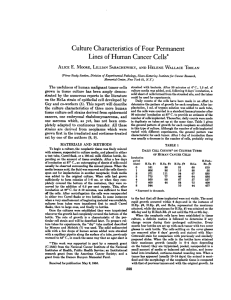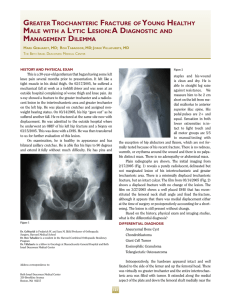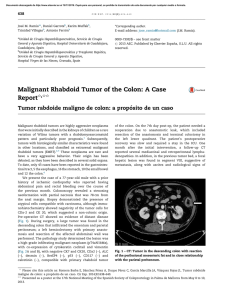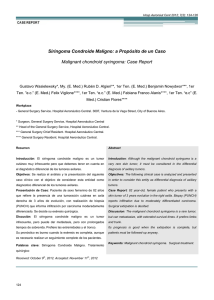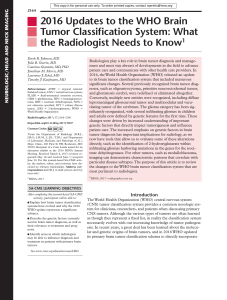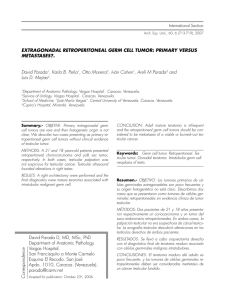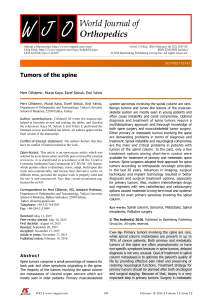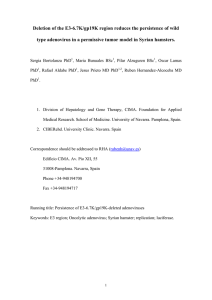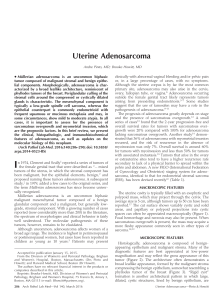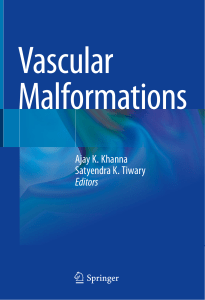Vascular Tumors Arising in the Chest Wall: 25 Years` Experience
Anuncio
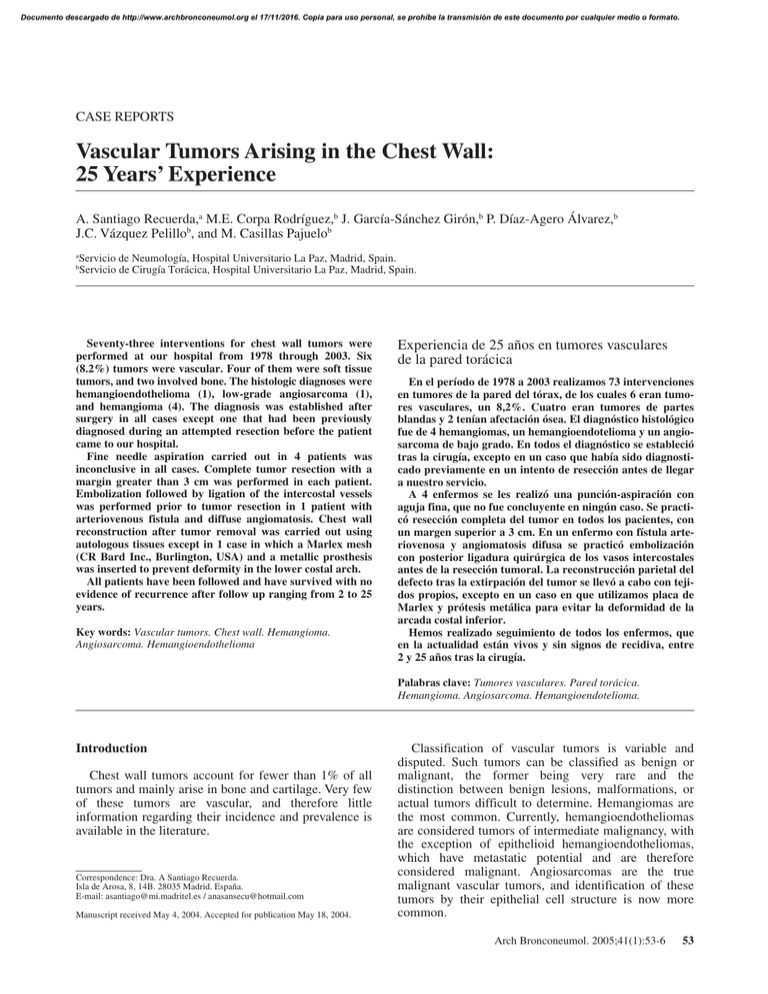
Documento descargado de http://www.archbronconeumol.org el 17/11/2016. Copia para uso personal, se prohíbe la transmisión de este documento por cualquier medio o formato. CASE REPORTS Vascular Tumors Arising in the Chest Wall: 25 Years’ Experience A. Santiago Recuerda,a M.E. Corpa Rodríguez,b J. García-Sánchez Girón,b P. Díaz-Agero Álvarez,b J.C. Vázquez Pelillob, and M. Casillas Pajuelob a Servicio de Neumología, Hospital Universitario La Paz, Madrid, Spain. Servicio de Cirugía Torácica, Hospital Universitario La Paz, Madrid, Spain. b Seventy-three interventions for chest wall tumors were performed at our hospital from 1978 through 2003. Six (8.2%) tumors were vascular. Four of them were soft tissue tumors, and two involved bone. The histologic diagnoses were hemangioendothelioma (1), low-grade angiosarcoma (1), and hemangioma (4). The diagnosis was established after surgery in all cases except one that had been previously diagnosed during an attempted resection before the patient came to our hospital. Fine needle aspiration carried out in 4 patients was inconclusive in all cases. Complete tumor resection with a margin greater than 3 cm was performed in each patient. Embolization followed by ligation of the intercostal vessels was performed prior to tumor resection in 1 patient with arteriovenous fistula and diffuse angiomatosis. Chest wall reconstruction after tumor removal was carried out using autologous tissues except in 1 case in which a Marlex mesh (CR Bard Inc., Burlington, USA) and a metallic prosthesis was inserted to prevent deformity in the lower costal arch. All patients have been followed and have survived with no evidence of recurrence after follow up ranging from 2 to 25 years. Key words: Vascular tumors. Chest wall. Hemangioma. Angiosarcoma. Hemangioendothelioma Experiencia de 25 años en tumores vasculares de la pared torácica En el período de 1978 a 2003 realizamos 73 intervenciones en tumores de la pared del tórax, de los cuales 6 eran tumores vasculares, un 8,2%. Cuatro eran tumores de partes blandas y 2 tenían afectación ósea. El diagnóstico histológico fue de 4 hemangiomas, un hemangioendotelioma y un angiosarcoma de bajo grado. En todos el diagnóstico se estableció tras la cirugía, excepto en un caso que había sido diagnosticado previamente en un intento de resección antes de llegar a nuestro servicio. A 4 enfermos se les realizó una punción-aspiración con aguja fina, que no fue concluyente en ningún caso. Se practicó resección completa del tumor en todos los pacientes, con un margen superior a 3 cm. En un enfermo con fístula arteriovenosa y angiomatosis difusa se practicó embolización con posterior ligadura quirúrgica de los vasos intercostales antes de la resección tumoral. La reconstrucción parietal del defecto tras la extirpación del tumor se llevó a cabo con tejidos propios, excepto en un caso en que utilizamos placa de Marlex y prótesis metálica para evitar la deformidad de la arcada costal inferior. Hemos realizado seguimiento de todos los enfermos, que en la actualidad están vivos y sin signos de recidiva, entre 2 y 25 años tras la cirugía. Palabras clave: Tumores vasculares. Pared torácica. Hemangioma. Angiosarcoma. Hemangioendotelioma. Introduction Chest wall tumors account for fewer than 1% of all tumors and mainly arise in bone and cartilage. Very few of these tumors are vascular, and therefore little information regarding their incidence and prevalence is available in the literature. Correspondence: Dra. A Santiago Recuerda. Isla de Arosa, 8, 14B. 28035 Madrid. España. E-mail: [email protected] / [email protected] Manuscript received May 4, 2004. Accepted for publication May 18, 2004. Classification of vascular tumors is variable and disputed. Such tumors can be classified as benign or malignant, the former being very rare and the distinction between benign lesions, malformations, or actual tumors difficult to determine. Hemangiomas are the most common. Currently, hemangioendotheliomas are considered tumors of intermediate malignancy, with the exception of epithelioid hemangioendotheliomas, which have metastatic potential and are therefore considered malignant. Angiosarcomas are the true malignant vascular tumors, and identification of these tumors by their epithelial cell structure is now more common. Arch Bronconeumol. 2005;41(1):53-6 53 Documento descargado de http://www.archbronconeumol.org el 17/11/2016. Copia para uso personal, se prohíbe la transmisión de este documento por cualquier medio o formato. SANTIAGO RECUERDA A, ET AL. VASCULAR TUMORS ARISING IN THE CHEST WALL: 25 YEARS’ EXPERIENCE Figure 1. Tridimensional reconstruction of the chest wall where the costal lesion caused by the hemangioendothelioma is visible. A review of the literature yields only isolated cases of vascular tumors, rather than any major series reporting a significant number of cases. We report a case series of 6 vascular tumors diagnosed over a period of 25 years. All the patients underwent surgery and are still being followed. Descriptive statistics are presented as means (SD) for quantitative variables and frequencies and percentages for qualitative variables. Case Descriptions Seventy-three chest wall tumor operations were carried out from 1978 to 2003. Six (8.2%) of these tumors were vascular. The mean age of the patients (5 men and 1 woman) was 38 (13) years (range, 22-55 years). The tumors were discovered incidentally in chest x-rays in 2 of the patients and were palpable in the remaining 4 patients, progressively increasing in size over the course of 6, 12, and 13 months, and several years, respectively. The tumor in the last case, diagnosed when the patient was young, grew to 25 cm in diameter and a cutaneous ulcer developed at the largest part of the tumor. None of the tumors were painful. The tumors were located in the right side of the chest in 4 cases and in the left side in 2 cases; 3 tumors were found in the anterior costal region, while the other 3 were posterior. The tumors were seen in chest x-rays in 4 cases; 2 of them involved ribs, and the other 2 involved soft tissues only. The small size of the other 2 tumors made visualization impossible. Computed tomography (CT) scans of the chest were performed in 4 patients, and noncomputed chest tomograms were carried out in the other 2 as CT was not available at the time of presentation. Figure 1 shows the costal lesion in the hemangioendothelioma case. Fine-needle aspiration biopsies carried out in 4 patients were inconclusive. Table 1 shows patient and tumor characteristics and diagnostic methods. All tumors were fully resected with tumor-free margins. Only involved muscle attached to the soft tissue tumors was resected, and in 1 case, an underlying rib was also resected due to tumor proximity. In 1 case of bone tumor, an extensive rib resection including the upper and lower intercostal spaces was performed. In the second bone tumor, located in the posterior gutter, the technique was en bloc resection of 3 ribs to the transverse process. Chest wall reconstruction was required for this patient. A Marlex mesh (CR Bard Inc, Burlington, USA) and a metallic prosthesis were inserted to prevent lower costal arch deformity. A thoracotomy was performed prior to resection to treat the patient with an arteriovenous fistula and diffuse angiomatosis because a previous embolization had been unsuccessful. Ligation of the large, tortuous afferent vessels, evident in an earlier arteriograph, was performed during the thoracotomy (Figure 2). Despite the ligation, the wellvascularized tumor hemorrhaged severely due to the size and vascular malformation. Tumor size varied from 2 to 25 cm in diameter, and histology revealed 4 hemangiomas (capillary, intramuscular, cavernous bone, and arteriovenous malformation with diffuse angiomatosis), a hemangioendothelioma, and an angiosarcoma. Table 2 lists the tumor size, type of resection, and definitive histological diagnosis. No postsurgical morbidity or tumor recurrence developed in any of the cases. Neither chemo- nor radiotherapy was administered. All patients have continued follow up and are currently disease-free after a period ranging from 2 to 25 years. TABLE 1 Patient Characteristics, Signs and Symptoms, and Diagnostic Methods* Case Age Sex Signs and Symptoms 1 29 M Asymptomatic Right anterior wall 2 3 29 45 M M Palpable tumor Asymptomatic Right anterior wall Right anterior wall 4 46 M Palpable giant tumor Left anterolateral wall 5 55 M Palpable tumor Left posterior wall 6 22 F Palpable tumor Right posterior wall *FNA indicates fine-needle aspiration; M, male; and F, female. 54 Arch Bronconeumol. 2005;41(1):53-6 Site Radiolography Incidental finding. Soft tissue involvement Soft tissue involvement Incidental finding. Rib 5 involvement Soft tissue involvement. Aortograph Extrapleural mass with involvement of 3 ribs Not visible FNA Negative Not performed Blood smear Prior open biopsy Blood smear Fusocellular proliferation (inconclusive) Documento descargado de http://www.archbronconeumol.org el 17/11/2016. Copia para uso personal, se prohíbe la transmisión de este documento por cualquier medio o formato. SANTIAGO RECUERDA A, ET AL. VASCULAR TUMORS ARISING IN THE CHEST WALL: 25 YEARS’ EXPERIENCE Discussion Vascular tumors arising in the chest wall are very rare, and no major series is available in the literature. Only isolated cases are reported.1-7 Benign tumors are exceptional, and it is difficult to determine histologically if they are actual tumors, merely benign lesions, or malformations.8,9 The most common type of benign tumor is the hemangioma,10 which is characterized by vascular channels in muscle or in the medullary canal (bone hemangiomas). Both types are rare, and only isolated cases have been reported in Spain.5,11 According to Watson and McCarty,6 hemangiomas in the chest wall are very rare, accounting for 0.7% of all hemangiomas. They are mainly located in the posterior or lateral chest regions, although such tumors were located in the anterior region in 2 of our cases. Normally such tumors appear in young adults or in children, such that some authors believe them to be congenital2,7; however, both the anterior hemangiomas in our series appeared in the third decade of life. Hemangiomas have also been associated with muscle trauma, which leads to their development through a process of vascular proliferation at the center of a hematoma.12 Bone hemangiomas account for 1% of all bone tumors, and they are very rare in the costal wall.13 They are characterized by radiolucent costal bulging and a finely trabeculated lesion on the cortex of the rib. Such tumors are normally painless, and large-sized tumors are therefore discovered by conventional radiography as in case 3 of our series. Establishing the diagnosis before surgery is difficult and, given the nonspecific nature of the radiographic features, it is easy to confuse these tumors with other malignant bone lesions that would require extensive tumor resection. The rare development of diffuse angiomatosis following arteriovenous fistulas is an extensive form of hemangioma that involves distinct tissues (skin, subcutaneous tissue, muscle, and occasionally, bone). Angiomatosis is synonymous with vascular malformation and is considered by many to be a congenital malformation usually discovered at an early age.8,14 Figure 2. Computed tomography scan of the chest in which the tumor, 8 cm in diameter with costal wall infiltration, is observed in the left dorsal region. Angiomatosis may remain painless for a long time and grow to a large size, possibly leading to necrosis and ulceration. The vascular nature of these tumors can be revealed by contrast-enhanced CT scans, even though they have a fatty appearance on the surface because they are mainly composed of mature adipose tissue. This misleading image is seen in sonograms as well. Lipoma was the initial diagnosis in case 4 of our series, and when extensive vascularization of the tumor was discovered during resection, the procedure was halted for arteriography, which demonstrated vascular proliferation deriving from the intercostal, internal mammary, and diaphragmatic arteries. Recurrences after resection have been reported after treatment of very extensive lesions with deep involvement of certain chest wall tissues. Hemangioendotheliomas are sarcomas of intermediate malignancy and difficult to diagnose. They can grow large and are usually painless. In case 5 of our series the tumor caused bulging at ribs 8, 9, and 10 without invading the cortex. The tumor had peripheral TABLE 2 Surgery Performed, Tumor Size, and Histological Diagnosis Case Size (cm) Bone Involvement 1 2 3 6×5 2×2 7×6.5 No No Yes 4 25×10 No 5 8.5×5 Yes 6 3.5×2 No Year. Intervention Histological Diagnosis 1978. Wall resection 1985. Soft tissue resection en bloc 1990. Resection of rib 5 and adjacent muscles pectoralis major and serratus flaps 2002. Thoracotomy and ligature of afferent vessels. Elliptical excision of skin, subcutaneous, and muscle tissues. Extensive skin flap to close the wall defect 2002. Pedicle ligature. Tumor excision with en bloc resection of 3 ribs. Marlex mesh and metal prosthesis. Reconstruction of latissimus dorsi 1996. In bloc resection of skin, muscle, and rib number 10. Myoplasty Intramuscular capillary hemangioma Cavernous hemangioma Bone hemangioma Arteriovenous with diffuse angiomatosis Well-defined hemangioendothelioma Low-grade angiosarcoma Arch Bronconeumol. 2005;41(1):53-6 55 Documento descargado de http://www.archbronconeumol.org el 17/11/2016. Copia para uso personal, se prohíbe la transmisión de este documento por cualquier medio o formato. SANTIAGO RECUERDA A, ET AL. VASCULAR TUMORS ARISING IN THE CHEST WALL: 25 YEARS’ EXPERIENCE calcifications and projected deeply into the outer pleura. A contrast-enhanced CT scan reveals vascular proliferation inside the tumor, and fine-needle aspiration can produce severe bleeding because of arterial involvement and pressure in the center of the tumor. Bone scans are usually positive. The epithelioid hemangioendothelioma variant is considered malignant due to its metastatic potential. Angiosarcomas are the true malignant vascular tumors. They arise in the endothelial cells of the small blood vessels and are extremely rare in the chest wall. In a review of the Japanese literature, Naka et al4 reported a series in which only 2 out of 99 cases of angiosarcomas originated in the chest. The typical epithelial appearance of these tumors is revealed through histology while their endothelial origin is confirmed by immunohistochemical techniques. Angiosarcomas usually have a very poor prognosis, and their grade of malignancy ranges from 1 to 3, depending on their cellular features. Grades 2 and 3 have a very poor prognosis, with death coming within a few months despite treatment. Angiosarcomas caused by irradiation, infections, tuberculosis, etc have been reported.15,16 In a review of the literature prior to 1998, Alexiou et al3 found only 6 cases of angiosarcomas, and all of these patients had reported intense pain. Low-grade angiosarcoma was diagnosed in case 6 of our series, but no pain was reported. The tumor was 3.5 cm in size, and complete resection with wide margins was performed. Surgery is the treatment of choice for such tumors although the prognosis for high-grade tumors remains poor regardless of the treatment applied. In conclusion, vascular tumors arising in the chest wall are extremely rare. We have surgically treated 4 benign tumors, 1 intermediate malignant tumor, and 1 low-grade malignant tumor. All the patients are currently alive. The interest of this case series lies in the rarity of vascular tumors. Our description has illustrated the difficulty of diagnosis, the scarcity of symptoms, and 56 Arch Bronconeumol. 2005;41(1):53-6 the nonspecific nature of radiographic studies, which makes intra-operative biopsy necessary to determine the size of the resection margin for the best long-term outcome. REFERENCES 1. King RM, Pairolero PC, Trastek VF, Piehler JM, Payne WS, Bernatz PE. Primary chest wall tumors: factors affecting survival. Ann Thorac Surg. 1986;41:597-601. 2. Walsh GL, Davis BM, Swisher SG, Vaporciyan AA, Smythe WR, Willis-Merriman K, et al. A single-institutional, multidisciplinary approach to primary sarcomas involving the chest wall requiring full thickness resections. J Thorac Cardiovasc Surg. 2001;121:4860. 3. Alexiou C, Clelland CA, Robinson D, Morgan WE. Primary angiosarcomas of the chest wall and pleura. Eur J Cardiothorac Surg. 1998;14:523-6. 4. Naka N, Ohsawa M, Tomita Y, Kanno H, Uchida A, Aozasa K. Angiosarcoma in Japan. A review of 99 cases. Cancer. 1995;75: 989-96. 5. Arrabal R, Fernández A, Pagés C, Benítez A, Fernández JL. Tumores primitivos de pared torácica (1991-1994). Arch Bronconeumol. 1996;32:384-7. 6. Watson WL, McCarty WD. Blood and lymph vessel tumor. A report of 1056 cases. Surg Ginecol Obstet. 1940;71:569-88. 7. Yonehara Y, Nakatsuka T, Ichioka I, Takato T, Matsumoto S, Yamada A. Intramuscular haemangioma of the anterior chest wall. Br J Plast Surg. 2000;53:257-9. 8. Fletcher C. Vascular tumours. In: Fletcher C, Unni K, Mertens F, editors. Pathology and genetics of tumours of soft tissue and bone. Lyon: WHO. IARC Press; 2002. p. 155-78. 9. Fletcher CD. Vascular tumors: an update with emphasis on the diagnosis of angiosarcoma and borderline vascular neoplasms. Monogr Pathol. 1996;38:181-206. 10. Dahlin DC. Bone tumors: general aspects and data on 6221 cases. Springfield: C. Thomas; 1987. p. 137-48. 11. de Granda JI, Baquero F, Ramírez JR. Hemangioma costal: un diagnóstico infrecuente. Arch Bronconeumol 2002;38:154-5. 12. Scott JL. Hemangiomata in skeletal muscle. Br J Surg. 1957;44: 496-501. 13. Shimizu K, Yamashita Y, Hihara J, Seto Y, Toge T. Cavernous hemangioma of the rib. Ann Thorac Surg. 2002;74:932-4. 14. Howat AJ, Campbell PE. Angiomatosis: a vascular malformation of infancy and childhood. Report of 17 cases. Pathology. 1987;19:377-82. 15. Maziak DE, Shamji FM, Peterson R, Perkins DG. Angiosarcoma of the chest wall. Ann Thorac Surg. 1999;67:839-41. 16. Maddox JC, Evans HL. Angiosarcoma of skin and soft tissues. Cancer. 1981;48:1907-21.
